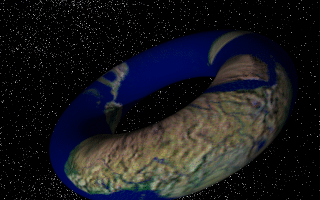The planet is centered on the origin and is in the XY plane with the Z axis as the axis of rotation. The hole of the donut has a radius of 1 unit (2000 mi) and the overall radius is 2 units (4000 mi).
Questions:
What is the direction of down on a donut-shaped planet?
How about the strength of the gravitational pull?
I'm thinking about writing a Civilization II style game based on a donut-shaped planet. However, I have a number of questions I need answered in order to write the program. List of questions.

I haven't been able to develop a formula for the horizontal component of the gravitational pull of a donut-shaped planet. However, the formula for the vertical gravitational pull of the planet as you pass through the center of the hole is
Pull (in gravities toward the top) =2 ¹ * cos(arctan( ![]() (2x sqrt(.25-x^2))dx) / 1.5) * ((g*
(2x sqrt(.25-x^2))dx) / 1.5) * ((g*![]() 2 * sqrt(.25 - x^2)dx) /
(sqrt(2.25 +
2 * sqrt(.25 - x^2)dx) /
(sqrt(2.25 +
![]() (2x sqrt(.25 - x^2))dx)))
(2x sqrt(.25 - x^2))dx)))
Pull (towards the bottom) = 2 ¹ * cos(arctan( ![]() (2x sqrt(.25-x^2))dx) / 1.5) * ((g*
(2x sqrt(.25-x^2))dx) / 1.5) * ((g*![]() 2 *
sqrt(.25 - x^2)dx) / (sqrt(2.25 +
2 *
sqrt(.25 - x^2)dx) / (sqrt(2.25 + ![]() (2x sqrt(.25 - x^2))dx)))
(2x sqrt(.25 - x^2))dx)))
Total pull toward the top = (Pull towards top - Pull towards bottom)
Is this formula applicable for finding the vertical pull at other points on and around the planet?
If the net gravitational pull from anywhere on the planet is towards the center of the planet, then the formula for the apparent slope of the ground from anywhere on the planet is:
direction = arctan(sqrt(.25 - (1.5 - x)^2)/x) - arctan(-sqrt(.25 - (1.5 - x)^2)/(1.5 - x)^2)
where x is the distance from the center of the planet in units and all angles are in degrees.
sqrt(function): Square root of the function
arctan: Arc tangent
Matching parenthesis are the same size.
^ Raised to the power of
^2 Squared
g is the gravitational constant. In this case it is equal to 0.5407618837.